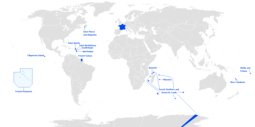Adélie Land
Adélie Land Terre Adélie | |
|---|---|
 Coat of arms
| |
| Motto: "Liberté, égalité, fraternité" | |
| Anthem: "La Marseillaise" | |
 | |
| Capital and largest city | Dumont d'Urville Station |
| Official languages | French |
| Demonym(s) | French |
| Government | |
| Emmanuel Macron | |
• Administrator | Cécile Pozzo di Borgo[1] |
• Head of District | François Grosvalet[2] |
| French overseas territory | |
• Discovered and claimed by France | January 20th, 1840 |
• Administrated from French Madagascar | 1924 |
• Administered as a district of the French Southern and Antarctic Lands | 1955 |
| Area | |
• Total | 432,000 km2 (167,000 sq mi) |
| Population | |
• Estimate | c. 33 (winter) < 80 (summer) |
| Currency | Euro (EUR) |
| Time zone | UTC+10 |
| Calling code | |
| Internet TLD | .tf |
Adélie Land (French: Terre Adélie) is a claimed territory on the continent of Antarctica. It stretches from a portion of the Southern Ocean coastline all the way inland to the South Pole. France has administered it as one of five districts of the French Southern and Antarctic Lands since 1955 and applied the Antarctic Treaty System rules since 1961. Article 4 deals with territorial claims, and although it does not renounce or diminish any preexisting claims to sovereignty, it also does not prejudice the position of Contracting Parties in their recognition or non-recognition of territorial sovereignty. France has had a permanent station in Adélie Land since April 9, 1950. The current Dumont d'Urville Station has a winter population around 25, but this goes up to about 78 during the Antarctic summer.
Geography[]
Adélie Land lies between 136° E (near Pourquoi Pas Point at 66°12′S 136°11′E / 66.200°S 136.183°E) and 142° E (near Point Alden at 66°48′S 142°02′E / 66.800°S 142.033°E), with a shore length of about 350 kilometres (220 mi) and with its inland part extending as a sector of a circle about 2,600 kilometres (1,600 mi) toward the South Pole. Adélie Land has borders with the Australian Antarctic Territory both on the east and on the west, namely on Clarie Land (part of Wilkes Land) in the west, and George V Land in the east. Its total land area, mostly covered with glaciers, is estimated to be 432,000 square kilometres (167,000 sq mi).
History[]
The coast of Adélie Land was discovered in January 1840 by the French explorer Jules Dumont d'Urville (1790–1842) who named it after his wife, Adèle.[3] This is the basis of the French claim to this Antarctic land.
Image Gallery[]

Discovery by Jules Dumont d'Urville, 1840

Rocks brought back by the expedition in January 1840 (Muséum de Toulouse)
Research stations[]
Dumont d'Urville Station[]
Since January 12, 1956, a staffed French research base has been located year-round at 66°40′S 140°01′E / 66.667°S 140.017°E, the Dumont d'Urville Station, with a winter population around 25, but this goes up to about 78 during the Antarctic summer.
Port Martin[]
The first French station, Port Martin, was built April 9, 1950, at 66°49′04″S 141°23′39″E / 66.81778°S 141.39417°E, but it was destroyed by a fire during the night of January 22–23, 1952. Port Martin housed a winter population of 11 in 1950–51 and 17 in 1951–52.[4]
Charcot Station[]
Charcot Station (69°22′30″S 139°01′00″E / 69.375°S 139.016667°E) was a French inland base located on the Antarctic ice sheet at 320 kilometres (200 mi) from the coast and from Dumont d'Urville Station, at an elevation of about 2,400 metres (7,900 ft). The station, built for the International Geophysical Year of 1957–58, paid homage to Jean-Baptiste Charcot), and was occupied from January 1957 through 1960 housing alone[clarification needed] three men.
The base was composed of a main body of 24 square metres (the "barrack") which consisted of semicylindrical sections of sheet metal assembled end to end. This form was planned to best withstand the snow pressure accumulated on it. Horizontal galleries were connected to house scientific measurement devices, while a vertical air conduit opened a few metres above the snow level provided ventilation.
Cap Prud'Homme Camp[]
Cap Prud'Homme (66°41′28″S 139°53′44″E / 66.691104°S 139.895677°E) is an Italian-French camp, opened in 1994, located on the coast of the Antarctic ice sheet, in Adélie Land, about 5 km from Petrel Island, where the French Dumont d'Urville Station is. All the supplies and equipment for the Italian-French Concordia Station are transported by a combined convoy of up to 7 Caterpillar tractors from Cap Prud'Homme, with Kassbohrer (de) trailblazers and a team of up to 9 people; each convoy transports an average of 150 tons of payload.[5]
In popular culture[]
- The Dumont d'Urville research station was the filming location of the documentary March of the Penguins (2005).[6]
See also[]
- Adelie Land Meteorite
- Adélie Valley
- Research stations in Antarctica
- Antarctic field camps
References[]
- ^ Official nomination
- ^ List of chefs de district
- ^ Dunmore, John (2007). From Venus to Antarctica: The Life of Dumont D'Urville. Auckland: Exisle Publ. p. 209. ISBN 9780908988716.
- ^ "Fire destroys station in Antarctica, French expedition's loss". The Times. January 26, 1952.
- ^ "Cap Prud'Homme". Italiantartide. Archived from the original on May 29, 2019. Retrieved October 7, 2018.
- ^ "The Emperor's Close-Up". National Geographic's Adventure. National Geographic Society. 2007. Archived from the original on 5 June 2013. Retrieved 29 May 2013.
External links[]
- Outposts of Antarctica
- Adélie Land
- France and the Antarctic
- French Southern and Antarctic Lands
- Regions of Antarctica
- Lands of Antarctica
- Territorial claims in Antarctica
- Geography of the French Southern and Antarctic Lands

 WikiMiniAtlas
WikiMiniAtlas



